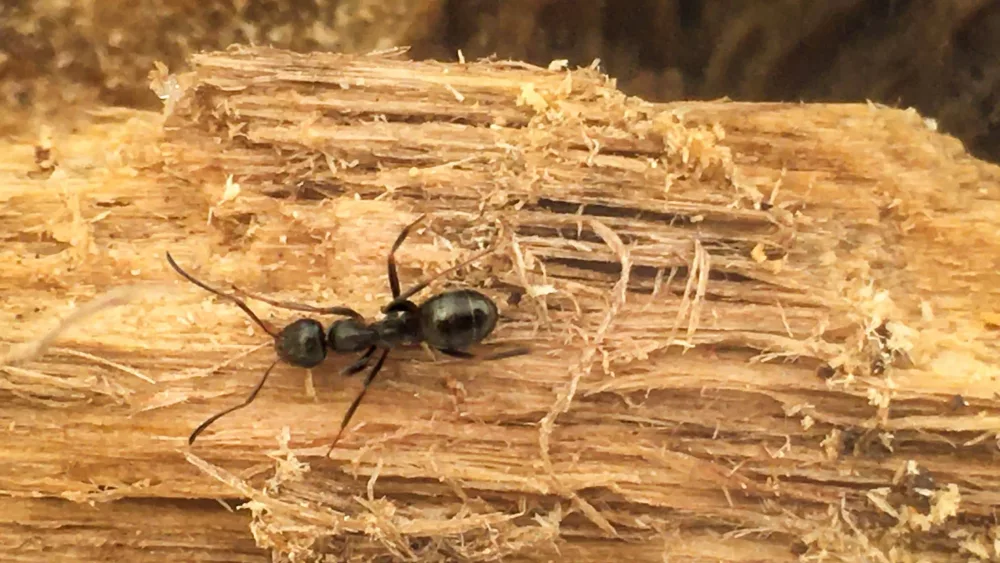Carpenter ants are among the largest ants in the United States. Workers of a colony may be up to 1/2 inch long. Their color may vary from a solid dull black or yellowish-red to a combination of black and dull red or reddish-orange. The black field ant and the Allegheny mound ant are two species that closely resemble the carpenter ant. Using a hand lens or microscope it is possible to discern the differences between these species.
Carpenter ants have only one segment or node between their thorax and abdomen, a circle of hairs at the tip of the abdomen, and an evenly rounded thorax when viewed from the side. Black field ants and Allegheny mound ants do not establish nests indoors and when found are considered occasional invaders in search of food. Winged carpenter ants may also resemble winged termites and it is important that they be identified correctly since control measures differ greatly for the two insect groups.

Carpenter ants are social insects that live in colonies, primarily in wood. They do not eat wood but are omnivorous, meaning they feed on both plant and animal foods including plant juices, fresh fruits, insects, sugars and fats. They do hollow out wood to build their nests, making velvety-smooth chambers where they rear their young, and it is this tunneling in wood that leads to their pest status in or around homes. A colony 3 to 6 years old may contain 2,000 to 3,000 ants. Under natural conditions, carpenter ants nest in live and dead trees and rotting logs and stumps. Occasionally they will construct nests in houses or other man-made wooden structures, especially if the structure has deteriorating wood which has been exposed to moisture.
Often, the colony will extend its nest to adjacent, sound wood. The most common rooms where people find carpenter ants are the bathroom and kitchen and this is often an indicator of a water leak or moisture problem. Outside the home they are commonly found in porch pillars, roofs, and window sills. Piles of wood fragments containing portions of insects or empty seed coats found below nest openings may be your first of indicator of a carpenter ant infestation.
Controlling carpenter ants requires that the nest be found. Once the nest location is found, control is simple but this first step may be the most challenging. Inspect behind bathroom tiles, around tubs, showers, sinks, dishwashers, and washing machines for signs of carpenter ants. Check wood affected by moisture from contact with the soil such as steps, porch supports, siding or where seepage from a gutter may contact wooden shingle roofs, hollow porch posts, columns, door or window frames. Sometimes nests are found in dry environments such as hollow veneer doors, curtain rods, and voids between the door casing and ceiling. To locate the nest, gently tap floor joists and other wooden surfaces with a hammer. A nest cavity gives a hollow ring. A knife blade will penetrate the wood if infested. Another technique is to place tiny piles of sugar at two to three foot intervals around the kitchen or bathroom.
Ants forage at night and you can use this bait to attract the workers and then trace them back to the nest entrance. An active colony may produce a distinct sound similar to crinkling of cellophane. In a quite room it may be possible to hear their activity behind walls. Sometimes ants are foraging indoors but may have a nest outdoors. Inspect tree branches or vines that touch the roof, electrical, and telephone wires, fences next to the house, piles of firewood, railroad ties, or hollow, living trees. Carpenter ants may travel as far as 100 yards from their nest to a food source, and it may be possible to follow foraging carpenter ants to find the nest.
Once the nest is found you can remove or repair the infested wood and treat the colony. If the colony is found indoors you may need to drill small holes three to six feet on either side of where the ants are entering into the wall voids, widow sills, or other areas to reach the nest. Dust formulations are particularly effective, as ant activities tends to spread the dust throughout the colony. Dust formulations include: carbaryl, bendiocarb, boric acid, permethrin and cyfluthrin. Spraying or dusting the baseboards or cracks and crevices around the infested area with residual insecticides, without locating and treating the nest, usually does not give complete control. Outside the structure, a perimeter spray applied against the foundation wall at least two feet up and three feet out can be effective in restricting carpenter ants.
Be sure to treat under the lower edge of sidings, around window and door frames and the chimney flashing. Insecticides may include: acephate, bendiocarb, boric acid, carbaryl, diatomaceous earth, and pyrethrins. Be sure to read the label as many of these products can only be used outdoors. Although some baits are labeled for carpenter ants, these have had varying degrees of success and are generally not considered effective. In difficult situations or when you cannot locate a nest, it may be best to employ a licensed pest control firm.
As with most situations, prevention is the best medicine. Avoid problems with carpenter ants by trimming all trees and shrubs that touch the house. Correct moisture problems such as leaking roofs as soon as they are found. Replace any rotted wood in your home and consider using a non-organic mulch against the foundation of your home to make it less attractive to carpenter ants.
— Kelly Jackson, Christian County Extension Agent






